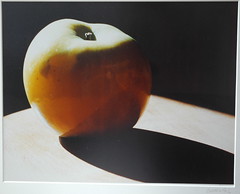Fruit can be exceedingly ugly. Not store fruit: that stuff is grown and waxed and arranged solely for its looks. But apple orchard apples, roadside squash, homegrown tomatoes and other garden vegetables often show the frustrations of their environment much more clearly than the over-coddled, over-produced produce of the supermarket. The apple in this picture is not a model apple. It is not vying for a spot on television. It is an apple with bad skin. It is strange, and slightly misshapen. Although it is exceedingly healthy, it is not beautiful. But it is made beautiful by the light it is in, by its simple arrangement on a wooden surface. By the light that lovingly caresses it, that defines it and sets it apart. This photograph has drawn a striking beauty from a homely apple.

The picture was taken by my father. Though he is not famous, his artistic aesthetic is a fundamental part of my world. And the things that drew him to this apple, and to light it, and frame it, and shoot it in the way he has, are the same things that draw me to pay attention, in particular ways, to the subjects of my poetry. I love the form and the sense of space inherent in the picture. I love the way the lumps of the apple resolve into the smooth, perfect lines of its shadow. I love the blend of the real and the ideal. On the one hand, this is clearly an apple made to be eaten. On the other hand, it has become a thing of beauty, and its complicated allure lies in the tension between these two things.
In Proust Was A Neuroscientist, Jonah Lehrer makes the argument that the function of art is to surprise -- to bring new ways of thinking (of seeing, of hearing) into our world, to disturb our complacent patterns of thought. But art is also about delight -- about creating tensions of form and structure, about seeing what is not easily seen, and showing it to others. Art can disturb the comfortable, sure. But it also can comfort the disturbed. It can reveal hidden beauties in the humblest, overlooked things. It can make an ugly old apple into a plaything of light and shadow.
